This page uses relevant student accommodation statistics in the UK for 2024, such as:
- The demand pool for student housing across different UK cities
- The number of new student rooms in the pipeline
- The average student rent and increases in 2024
- Student satisfaction rates with their accommodation
To produce this page, we’ve collated statistics from a range of authoritative sources including HEPI and Knight Frank.
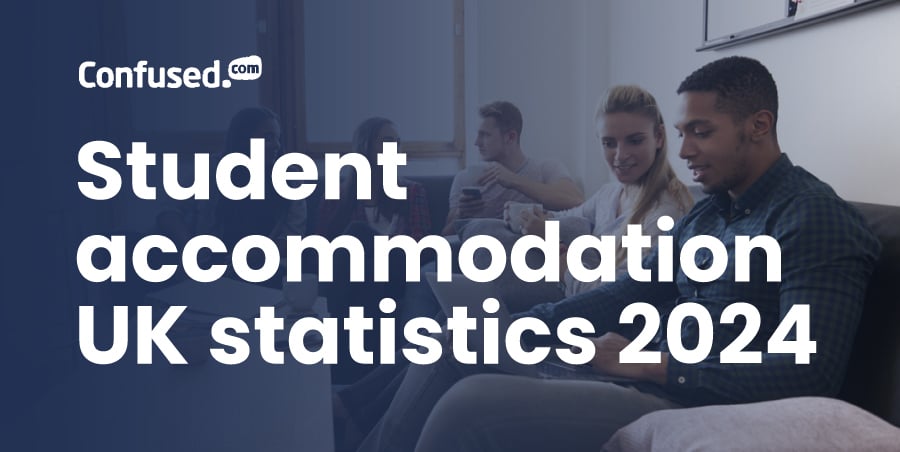
According to the latest UK student accommodation statistics, there’s going to be 2.2 million students needing accommodation by 2026. That’s an increase of almost 39% since 2021.
But there could be a shortage of 621,373 beds in 2026. This is due to supply shortages for purpose-built student accommodation (PBSA) and houses in multiple occupation (HMO) because of rising demand.
Because of the differences between the need for student housing and supply, we’ve collated a range of student housing statistics for 2024, including:
- The growth in the UK student market
- The ratio of students to beds in the UK
- How many companies are building new student accommodation sites
- The student rent increase across different UK cities
- Student housing satisfaction rates (including where they’re most satisfied and the biggest problems with their accommodation)
Top 10 UK student accommodation statistics for 2024
- London saw the biggest increase in full-time students from 2012/13 to 2021/22, at 79,320
- Nearly 1 in 3 (32%) students signed their tenancy agreement in August 2022
- There is expected to be a shortage of 371,763 student housing beds in 2024
- More than 4 in 10 (41%) PBSAs in 2023/24 are direct let
- There was a 66.7% decrease in the number of new PBSA beds being delivered from 2019 to 2023
- Over two-fifths (44%) of new student accommodation in the pipeline for 2023/24 were studio apartments
- Brighton had the fewest student housing options available under the average maintenance loan in 2023, with 5.9%
- Almost a third (31%) of students funded their accommodation costs by asking their parents to help with rent in 2023
- Over 4 in 5 students (82%) said that organised groups to combat loneliness was an important feature in their accommodation in 2022
- More than a third (36%) of students had problems with damp in their student accommodation in 2023
UK student accommodation market analysis
According to a student housing market report by Cushman & Wakefield, there was an average increase of 23,320 full-time students from 2012/13 to 2021/22. This data was taken from 10 locations in the UK.
The student housing market: The growth in student numbers across the UK
London saw the highest increase in full-time students from 2012/13 to 2021/22, with a substantial addition of 79,320 students over the decade.
A breakdown of the increase in full-time students from 2012/12 to 2021/22 across 10 UK cities

| Location | Increase in full-time students from 2012/13 to 2021/22 |
|---|---|
|
Cardiff
|
10,295
|
|
Leeds
|
11,825
|
|
Manchester
|
15,115
|
|
Liverpool
|
16,105
|
|
Edinburgh
|
16,645
|
|
Nottingham
|
17,265
|
|
Bristol
|
21,915
|
|
Glasgow
|
22,155
|
|
Birmingham
|
22,555
|
|
London
|
79,320
|
(Source: Cushman & Wakefield)
The capital’s growth in students was over 3 times as high as Birmingham's (22,555 additional students). It was more than 4 times as much as Liverpool's (16,105 additional students), and almost 8 times more than Cardiff (10,295 students).
Scotland's 2 largest cities, Glasgow and Edinburgh, saw a large difference in the increase of students over 10 years. While Glasgow accepted 22,155 more students, Edinburgh had 28.4% fewer, at 16,645.
The 3 cities bringing up the rear – Cardiff, Leeds, and Nottingham – all increased the number of full-time students at a pace below 16,000.
Preparing for university life? Use our complete student moving checklist. We outline everything you need to handle before the big day.
Where do students live during term time?
A UK PBSA market report by Statista shows that ‘other rented accommodation’ is the most common place for students to live during term time. This type of accommodation consists of privately rented properties that were not purpose-built and housed 598,390 students in 2021/22. This category has steadily increased over 5 years, rising by 12.5% from 531,715 students in 2017/18.
A breakdown of the most popular student accommodation types between 2017 and 2022
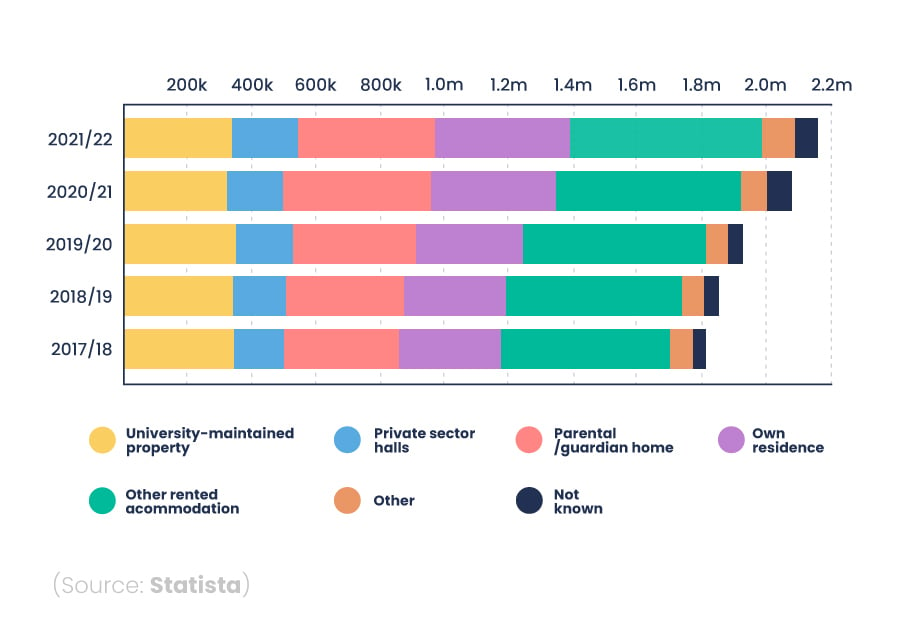
| 2017/18 | 2018/19 | 2019/20 | 2020/21 | 2021/22 | |
|---|---|---|---|---|---|
|
University-maintained property
|
356,325
|
351,605
|
359,920
|
335,300
|
347,680
|
|
Private sector halls
|
150,725
|
160,670
|
176,980
|
171,280
|
200,895
|
|
Parental/guardian home
|
355,365
|
368,475
|
380,605
|
456,870
|
429,620
|
|
Own residence
|
317,300
|
316,355
|
332,880
|
391,150
|
419,825
|
|
Other rented accommodation
|
531,715
|
550,880
|
569,670
|
576,620
|
598,390
|
|
Other
|
67,810
|
67,250
|
67,570
|
79,690
|
104,325
|
|
Not known
|
40,375
|
42,845
|
46,865
|
74,510
|
64,440
|
(Source: Statista)
The second most common type of accommodation for students in 2021/22 was living in their parental or guardian home. Almost 430,000 (429,620) people attending university chose to stay home during that year.
Meanwhile, student housing statistics indicate that private sector halls have seen rapid expansion as an option. The number of students living in private halls grew from 150,725 in 2017/18 to 200,895 in 2021/22 — an increase of 33%.
In contrast, university-maintained properties have declined by 2.4% over this period. These housed 356,325 students in 2017/18, but it dropped to 347,680 in 2021/22.
The number of students living in their own residences has also surged over 5 years. This figure rose by 32.3% from 317,300 in 2017/18 to 419,825 in 2021/22.
When do students sign tenancy agreements for accommodation?
According to statistics on UK student accommodation from Knight Frank, the most popular times for students to sign accommodation tenancy agreements are in the late summer months. When comparing years, August and September made up around 60% of signings in both 2021 and 2022.
A breakdown of which month students signed their tenancy agreements in 2021 and 2022
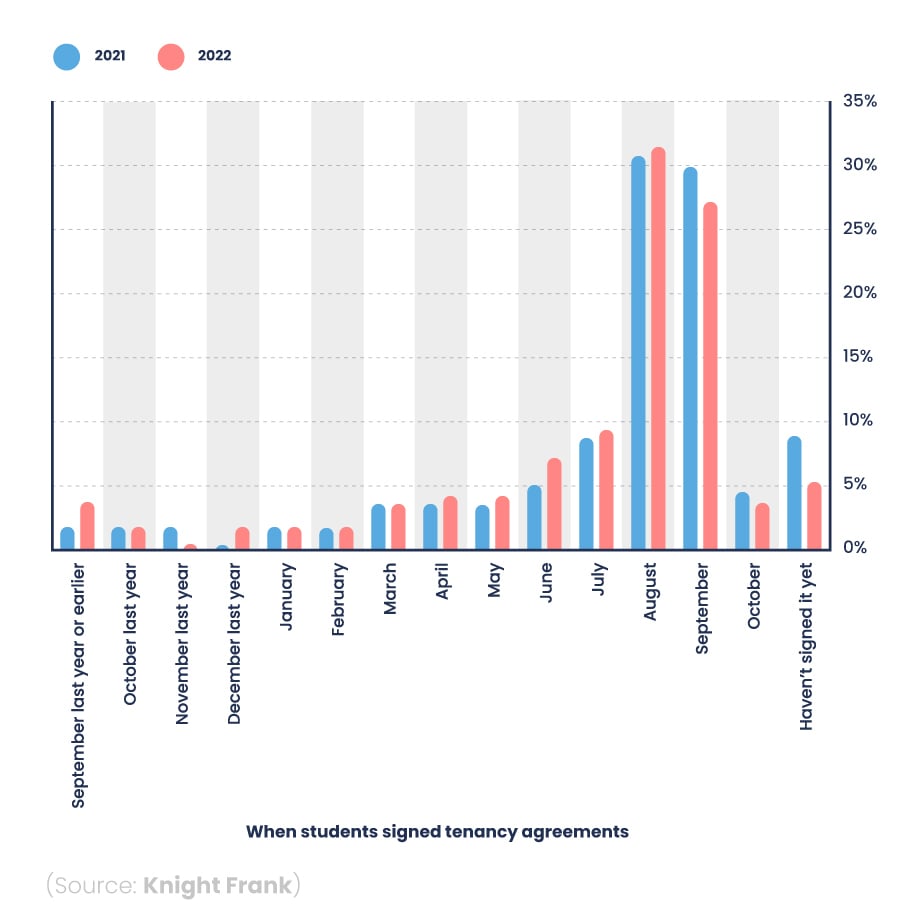
| When students signed tenancy agreements | 2021 | 2022 |
|---|---|---|
|
September last year or earlier
|
1%
|
3%
|
|
October last year
|
1%
|
1%
|
|
November last year
|
1%
|
0%
|
|
December last year
|
0%
|
1%
|
|
January
|
1%
|
1%
|
|
February
|
1%
|
1%
|
|
March
|
3%
|
3%
|
|
April
|
3%
|
4%
|
|
May
|
3%
|
4%
|
|
June
|
5%
|
7%
|
|
July
|
8%
|
9%
|
|
August
|
31%
|
32%
|
|
September
|
30%
|
27%
|
|
October
|
4%
|
3%
|
|
Haven’t signed it yet
|
8%
|
5%
|
(Source: Knight Frank)
In both 2021 and 2022, August was the peak month, with almost a third of students (31% and 32%, respectively) signing tenancy agreements in this period. September, the start of the academic year, also saw a rush of signings, with 30% in 2021 and 27% of students in 2022 finalising agreements. This pattern makes sense as students tend to secure accommodation ahead of the upcoming academic year when existing leases end and new ones become available.
However, more students signed earlier in summer 2022 compared to 2021. For example, 7% signed contracts in June 2022 versus 5% in the same month in 2021. This small uplift was also seen in July, with figures standing at 8% and 9%, respectively.
Of those who hadn’t signed agreements yet, 1 in 12 (8%) students were still hunting for housing after October in 2021. That’s compared to a marginally better 5% in 2022. Therefore, students need to secure the more-desirable locations earlier, or risk being in the 8% still hunting for accommodation at the start of term.
A UK student market report of the demand pool of accommodation across UK cities
The UK student accommodation market report by Cushman & Wakefield showed that the demand pool has increased for student accommodation. In fact, over 8 years, the demand grew at an average compound annual growth rate (CAGR) of 4.36% across 13 locations.
The demand pool refers to the number of students likely to demand a student bed within the student accommodation market (i.e. non-commuting students).
A breakdown of the student accommodation demand pool CAGR from 2013/14 to 2021/22 across the UK
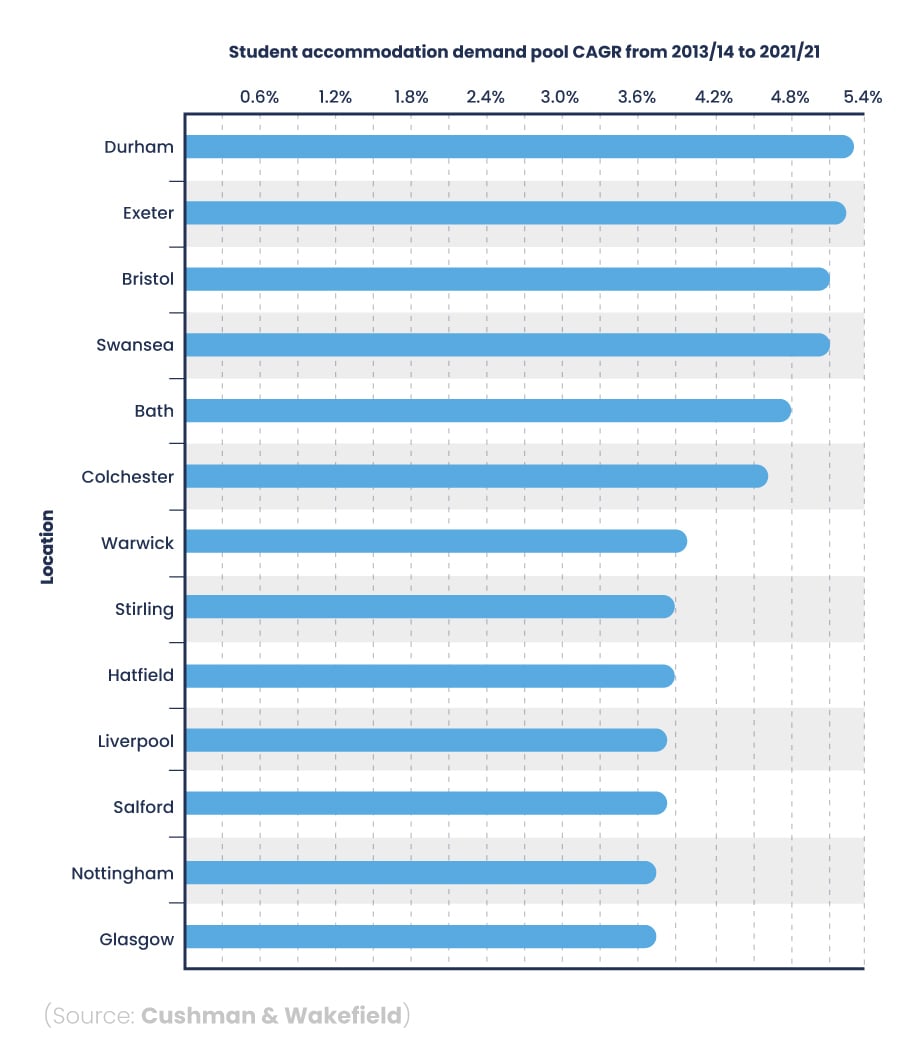
| Location | Student accommodation demand pool CAGR from 2013/14 to 2020/21 |
|---|---|
|
Durham
|
5.30%
|
|
Exeter
|
5.20%
|
|
Bristol
|
5.10%
|
|
Swansea
|
5.10%
|
|
Bath
|
4.80%
|
|
Colchester
|
4.60%
|
|
Warwick
|
4.00%
|
|
Stirling
|
3.90%
|
|
Hatfield
|
3.90%
|
|
Liverpool
|
3.80%
|
|
Salford
|
3.80%
|
|
Nottingham
|
3.70%
|
|
Glasgow
|
3.70%
|
(Source: Cushman & Wakefield)
Durham saw the fastest demand pool growth at 5.30%, significantly outpacing the average across all locations. This is 1.67% more than the location with the lowest rate, Glasgow, at 3.67%. Exeter, Bristol, and Swansea also saw a strong CAGR in excess of 5%.
Meanwhile, Bath, Colchester, and Warwick form a middle cluster with CAGRs ranging from 4.02% to 4.77%.
Outside of Glasgow, Nottingham and Salford had the slowest CAGR for the student accommodation demand pool between 2013/14 and 2020/21. With respective rates of 3.69% and 3.80%, these locations both fall under the average of 4.36%.
A breakdown of where international students make up the highest percentage of the total accommodation demand pool
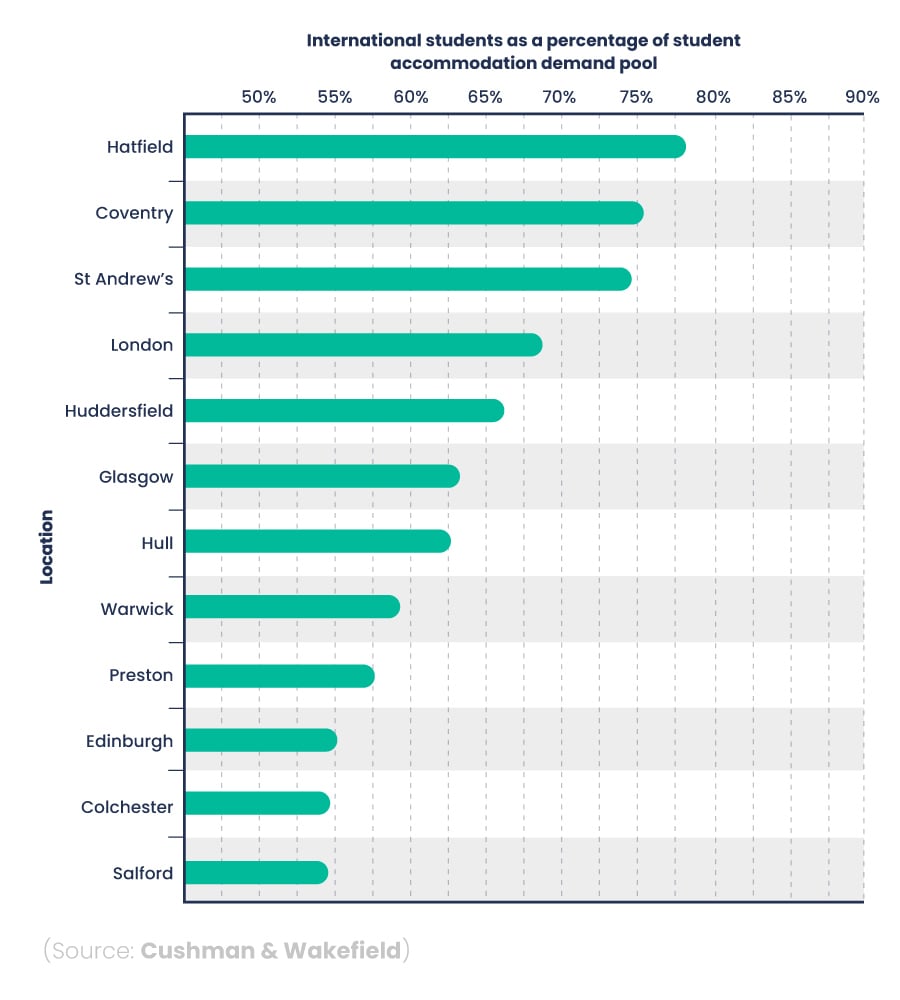
| Location | International students as a percentage of student accommodation demand pool |
|---|---|
|
Hatfield
|
78.20%
|
|
Coventry
|
75.10%
|
|
St Andrew’s
|
74.80%
|
|
London
|
68.80%
|
|
Huddersfield
|
66.80%
|
|
Glasgow
|
63.70%
|
|
Hull
|
62.90%
|
|
Warwick
|
58.20%
|
|
Preston
|
57.40%
|
|
Edinburgh
|
55.00%
|
|
Colchester
|
54.70%
|
|
Salford
|
54.50%
|
(Source: Cushman & Wakefield)
London has a high international student market across its universities. But it didn’t have the highest percentage of the demand pool at 68.8%. Hatfield had the highest percentage of international students looking for accommodation at 78.2% of the demand pool.
The statistics indicate that Coventry also has a high number of international students looking for accommodation at 75.1%. It beat St Andrew’s by a narrow margin of 0.3%.
Meanwhile, Glasgow (63.7%) slightly outpaces Hull (62.9%) with a 0.8% higher international student demand pool. However, both locations had about two-thirds of the total accommodation demand pool taken by international students.
Warwick's international student demand pool exceeds Preston's by around 0.8%. Additionally, Edinburgh claims a higher international student demand pool than Colchester by almost 0.3%.
The ratio of students to beds in the UK
In 2017, the bed demand was 1,412,688. Both HMO and PBSA supplies met this demand without any shortage. However, over the subsequent years, the gap between demand and supply has become more evident.
A breakdown of the bed demand and shortage in the UK from 2017 to 2026
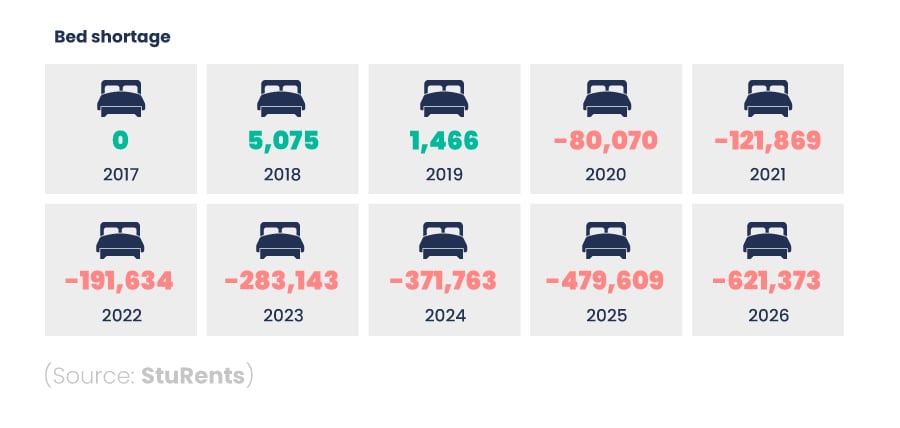
| Year | Bed demand | HMO supply | PBSA supply | Bed shortage |
|---|---|---|---|---|
|
2017
|
1,412,688
|
835,362
|
577,326
|
0
|
|
2018
|
1,438,811
|
835,362
|
608,524
|
5,075
|
|
2019
|
1,478,826
|
835,362
|
644,930
|
1,466
|
|
2020
|
1,586,198
|
835,362
|
670,766
|
-80,070
|
|
2021
|
1,650,077
|
835,362
|
692,846
|
-121,869
|
|
2022
|
1,738,619
|
835,362
|
711,623
|
-191,634
|
|
2023
|
1,842,644
|
835,362
|
724,139
|
-283,143
|
|
2024
|
1,965,620
|
835,362
|
758,495
|
-371,763
|
|
2025
|
2,112,775
|
835,362
|
797,804
|
-479,609
|
|
2026
|
2,291,180
|
835,362
|
834,445
|
-621,373
|
(Source: StuRents)
While the HMO supply has remained consistent since 2017, the PBSA supply has gradually increased — growing by 25.4% between 2017 and 2023. While there was a great supply of beds year-on-year, it was still not enough to keep up with the escalating bed demand since 2020.
Bed demand could surge to 2,291,180 by 2026. The combined HMO and PBSA supplies amount to 834,445, so this could result in a bed shortage of -621,373. This shortage is 409.7% higher than the one seen in 2021 (-121,869).
UK PBSA market report showing the percentage of beds by relationship with the university
The PBSA market report for the UK in the 2023/24 academic year shows a substantial 41% of PBSA beds are directly let to students.
A breakdown of the percentage of beds by relationship with the university
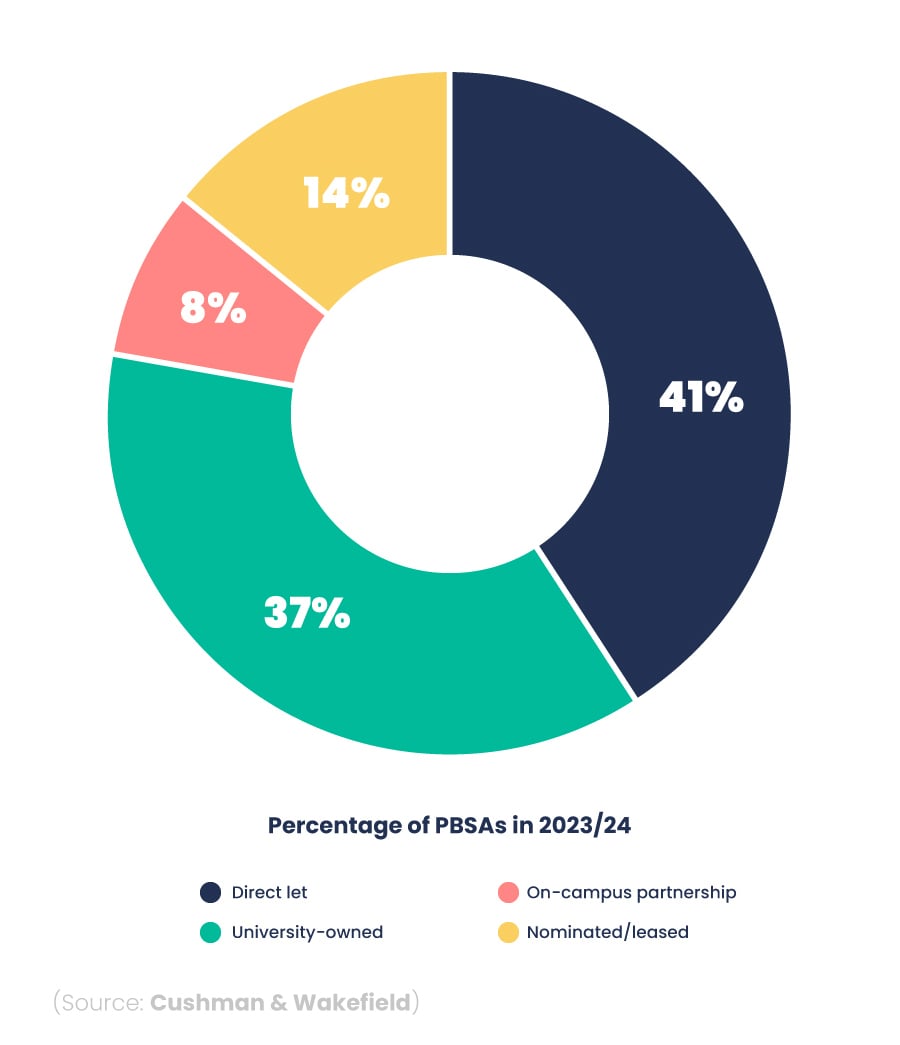
Outside of this private renting, almost 2 in 5 (37%) PBSA beds were university-owned in the academic year of 2023/24. Additionally, 14% of PBSA beds fall under the nominated/leased category in the same year.
The PBSA UK market report indicates a collaborative approach with an 8% share for on-campus partnerships. That’s in addition to direct let and university-owned categories. This model involves private accommodation providers working with universities to offer housing options.
New student accommodation statistics in the UK
Between 2019 and 2023, the number of new PBSAs being delivered in the UK has gradually fallen by -66.7%. That’s according to student housing statistics and research by StuRents.
The number of PBSA beds being delivered from 2019 to 2023
In 2019, the delivery of PBSA beds was at a peak of 36,000. This reflects a significant investment in new accommodation infrastructure to meet the growing demand from the student population.
A breakdown of the total number of new PBSA beds being delivered from 2019 to 2023
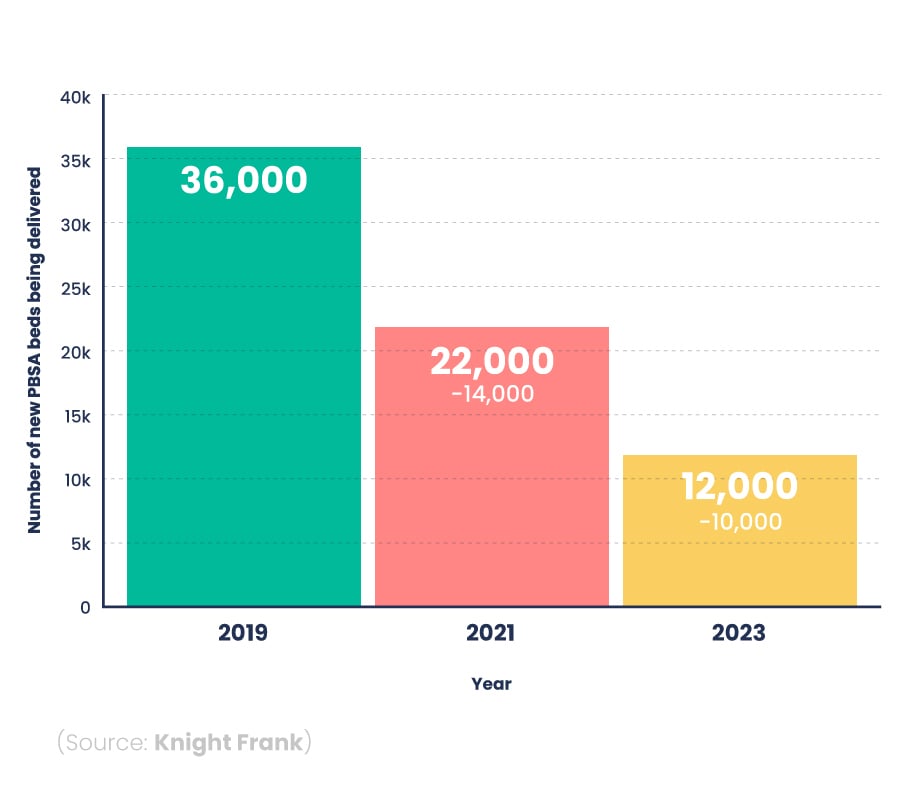
The years after 2019 reveal a decline in the number of new PBSA beds being delivered. In 2021, the number decreased to 22,000, indicating a relative slowdown in the pace of PBSA development. By 2023, the downward trend persists, with the delivery of new PBSA beds further reducing by -45.5% to 12,000.
The cities with the most student accommodation projects in the pipeline
In the UK, Bristol has the highest percentage of all PBSA beds in the pipeline for the 2023/24 academic year. This accounts for almost 1 in 8 (12%).
A breakdown of the UK cities with the highest percentage of beds in the pipeline for 2023/24
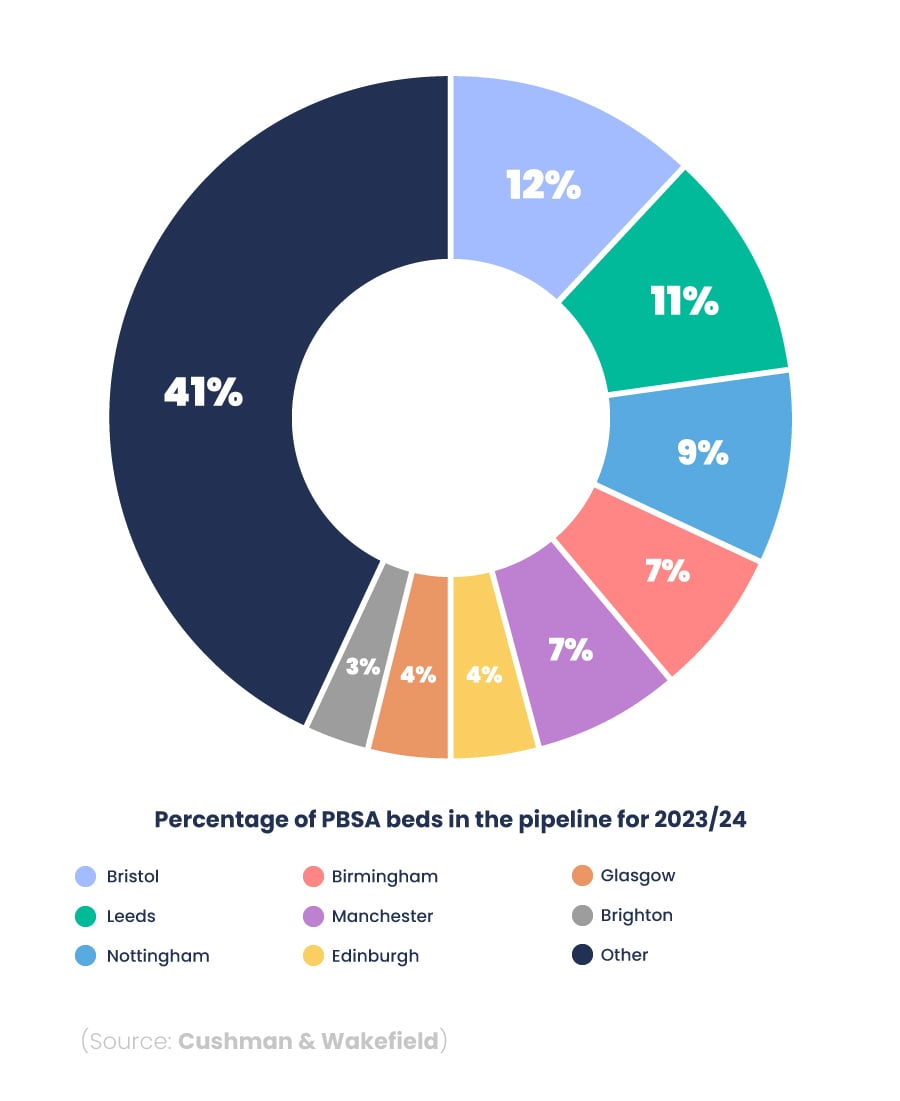
Following on from Bristol, Leeds and Nottingham are in the second and third positions with 11% and 9%, respectively.
Birmingham and Manchester share the fourth position, each with 7 in 100 (7%) PBSA beds in the pipeline for the 2023/24 academic year.
Edinburgh and Glasgow both have 1 in 25 (4%) of PBSA beds planned. This suggests ongoing efforts to enhance student housing availability in these cities. Brighton follows with 3%, indicating a moderate but noteworthy percentage of PBSA projects in development.
The ‘other’ category, encompassing various locations (including London), represents over two-fifths (43%) of PBSA beds planned for 2023/24.
A breakdown of the type of PBSAs planned for 2023/24
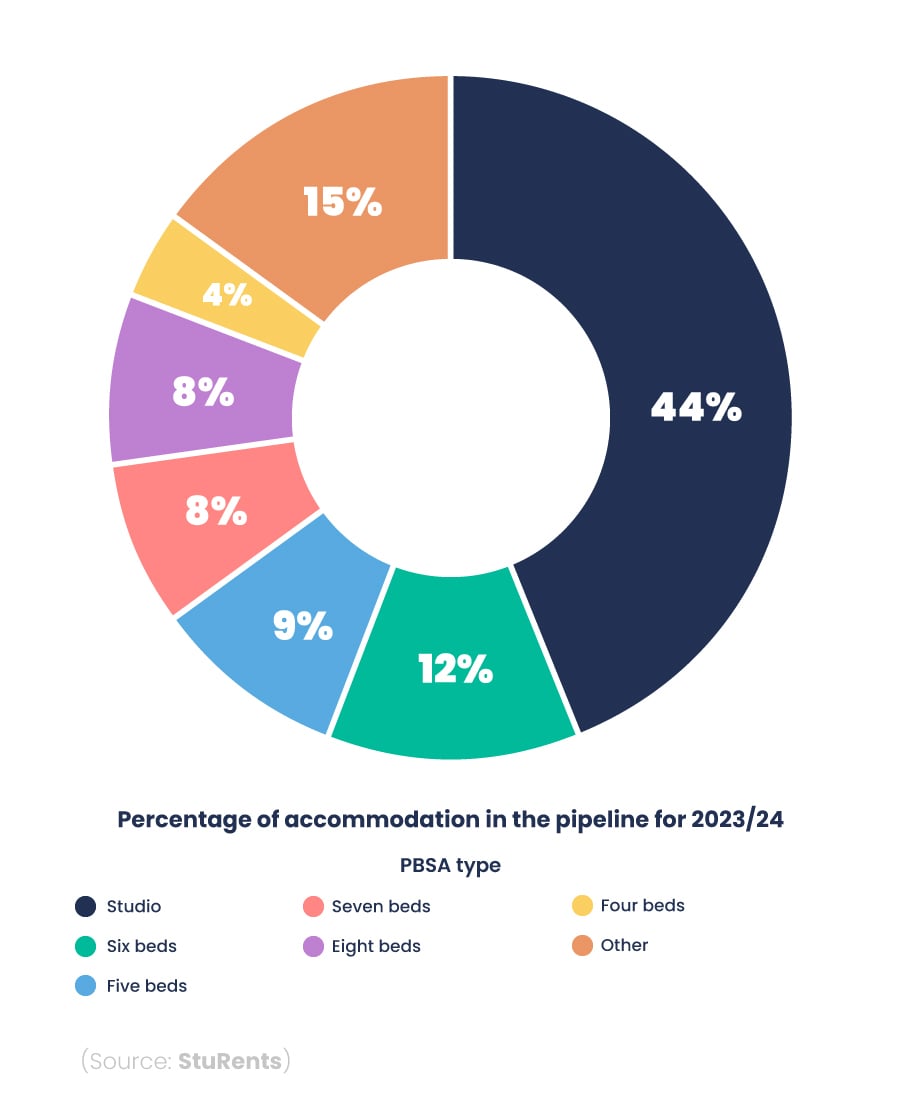
According to StuRents insights on UK student accommodation, studio apartments are the dominant category of housing. These make up over 4 in 10 (44%) of the PBSA accommodation planned for 2023/24. This is 40% more than the least common type of housing, 4-bed flats or houses.
Following studio housing, larger accommodations are popular. 6-bed housing represents 1 in 8 (12%) of beds in the pipeline. After these, 5 and 7-bed accommodations each account for 9% and 8%, respectively.
This is the same for 8-bed accommodations with 1 in 12 (8%) share in planned accommodation.
The top cities in the UK for student housing investment
The top city in the UK for student housing investment is Leeds. It delivered 2,328 beds. That’s 110.4% more than Edinburgh at 672.
This is according to data from Knight Frank on the top cities for student housing investment. It’s based on the total beds delivered in 2023/34 and ranks locations that have had substantial investment in student accommodation.
A breakdown of the total student beds delivered in 2023/24 in 10 UK cities
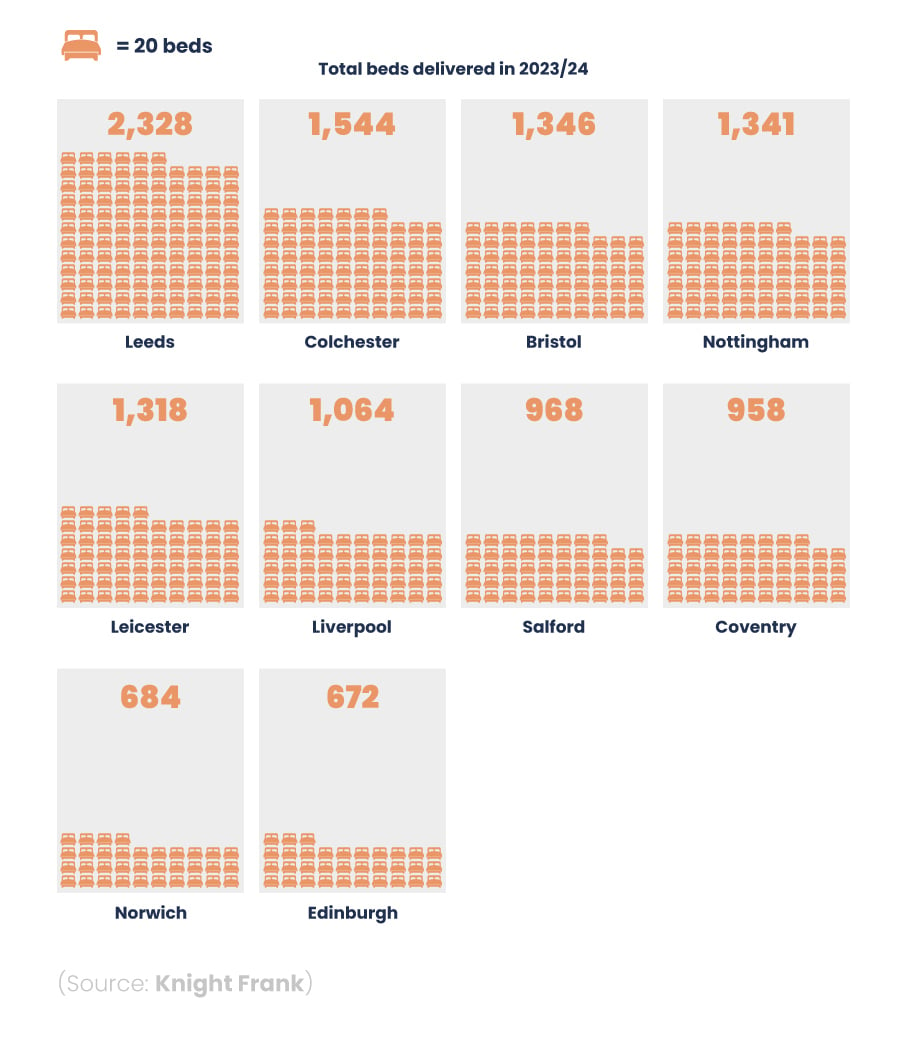
| Location | Total beds delivered in 2023/24 |
|---|---|
|
Leeds
|
2,328
|
|
Colchester
|
1,544
|
|
Bristol
|
1,346
|
|
Nottingham
|
1,341
|
|
Leicester
|
1,318
|
|
Liverpool
|
1,064
|
|
Salford
|
968
|
|
Coventry
|
958
|
|
Norwich
|
684
|
|
Edinburgh
|
672
|
(Source: Knight Frank)
Colchester follows Leeds with 1,544 beds delivered in the 2023/24 academic year, suggesting a considerable investment in providing accommodation options for students in this location.
Bristol, Nottingham, and Leicester secure the next positions, with 1,346, 1,341, and 1,318 beds delivered in 2023/24, respectively. While it shows a substantial student housing investment in these cities, there were still over 55.4% fewer beds delivered in these locations than in Leeds.
An overview of student accommodation rent costs and increases
Statistics from HEPI on student accommodation rent increases show there were widespread increases in weekly student rent from 2021/22 to 2023/24. This ranged from 2% to 24% across different UK cities.
UK student rent increases in 2023
There was an average student rent increase of 12% over different UK cities between 2021/22 and 2023/24 in university-owned accommodation. During the same period, there was an average 13% increase in private housing used by universities.
A breakdown of student rent increases in university-owned accommodation
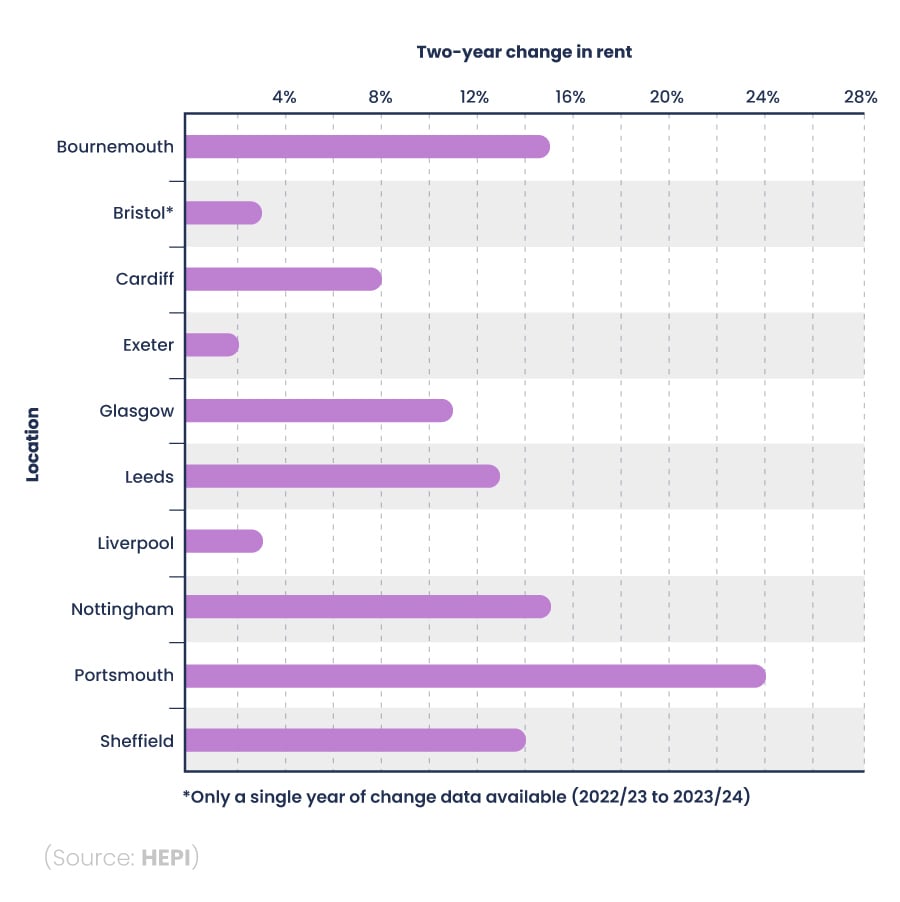
| Location | Weekly rent in 2023/24 | Two-year change in rent |
|---|---|---|
|
Bournemouth
|
£147
|
15%
|
|
Bristol
|
£182
|
3%*
|
|
Cardiff
|
£138
|
8%
|
|
Exeter
|
£220
|
2%
|
|
Glasgow
|
£148
|
11%
|
|
Leeds
|
£159
|
13%
|
|
Liverpool
|
£178
|
3%
|
|
Nottingham
|
£238
|
15%
|
|
Portsmouth
|
£168
|
24%
|
|
Sheffield
|
£148
|
14%
|
* Only a single year of change data available (2022/23 to 2023/24)
(Source: HEPI)
The data from HEPI on student rent increases in university-owned accommodation sheds light on the changing cost of living for students across the UK. Portsmouth exhibits the highest percentage increase, with a 24% rise in weekly rent over the years from 2021/22 to 2023/24.
Nottingham and Bournemouth also stand out with a notable change in rent, both experiencing a 15% increase in weekly rent over the two-year period. The student rent increases in Leeds, Sheffield, and Liverpool range from 13% to 14% — although this is 10% lower than the increases seen in Portsmouth.
In contrast, student housing statistics in Cardiff and Exeter demonstrate more moderate increases of 8% and 2%, respectively.
Bristol presents a unique case with only a single year of change data available. This shows a 3% increase in weekly rent from 2022/23 to 2023/24.
A breakdown of student rent increases in private accommodation used by universities
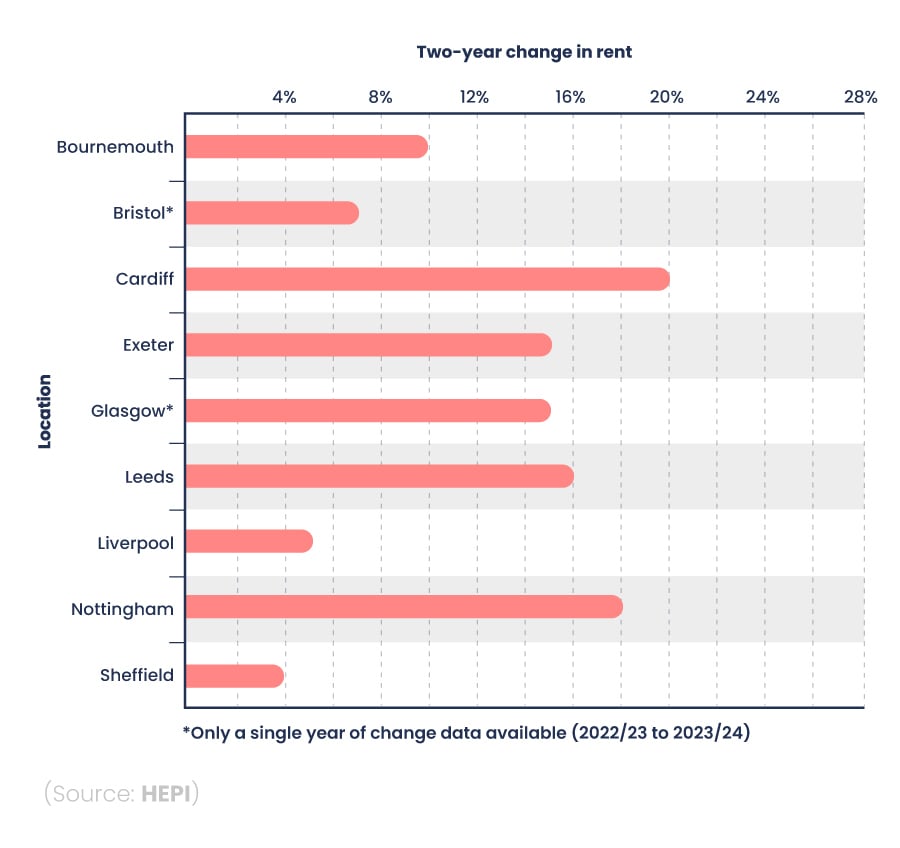
| Location | Weekly rent in 2023/24 | Two-year change in rent |
|---|---|---|
|
Bournemouth
|
£162
|
10%
|
|
Bristol
|
£203
|
9%*
|
|
Cardiff
|
£159
|
20%
|
|
Exeter
|
£184
|
15%
|
|
Glasgow
|
£178
|
15%*
|
|
Leeds
|
£166
|
16%
|
|
Liverpool
|
£136
|
5%
|
|
Nottingham
|
£165
|
18%
|
|
Sheffield
|
£133
|
4%
|
* Only a single year of change data available (2022/23 to 2023/24)
(Source: HEPI)
HEPI data on rent changes in private housing used by universities shows that students in Cardiff and Nottingham experienced increases of 20% and 18%, respectively, over two years. This is a 12% difference to the rent change in university-owned accommodation in Cardiff.
Leeds, Exeter, and Glasgow also show considerable increases in weekly rent, ranging from 15% to 16%.
Bristol and Sheffield demonstrate single-year change data, each with 9% and 4% increases in weekly rent, respectively. Although Sheffield’s rent increase in private accommodation is the same as university-owned housing, the cost of private student housing increased by 6% more in Bristol.
A breakdown of the percentage of student beds available under the average maintenance loan in UK cities
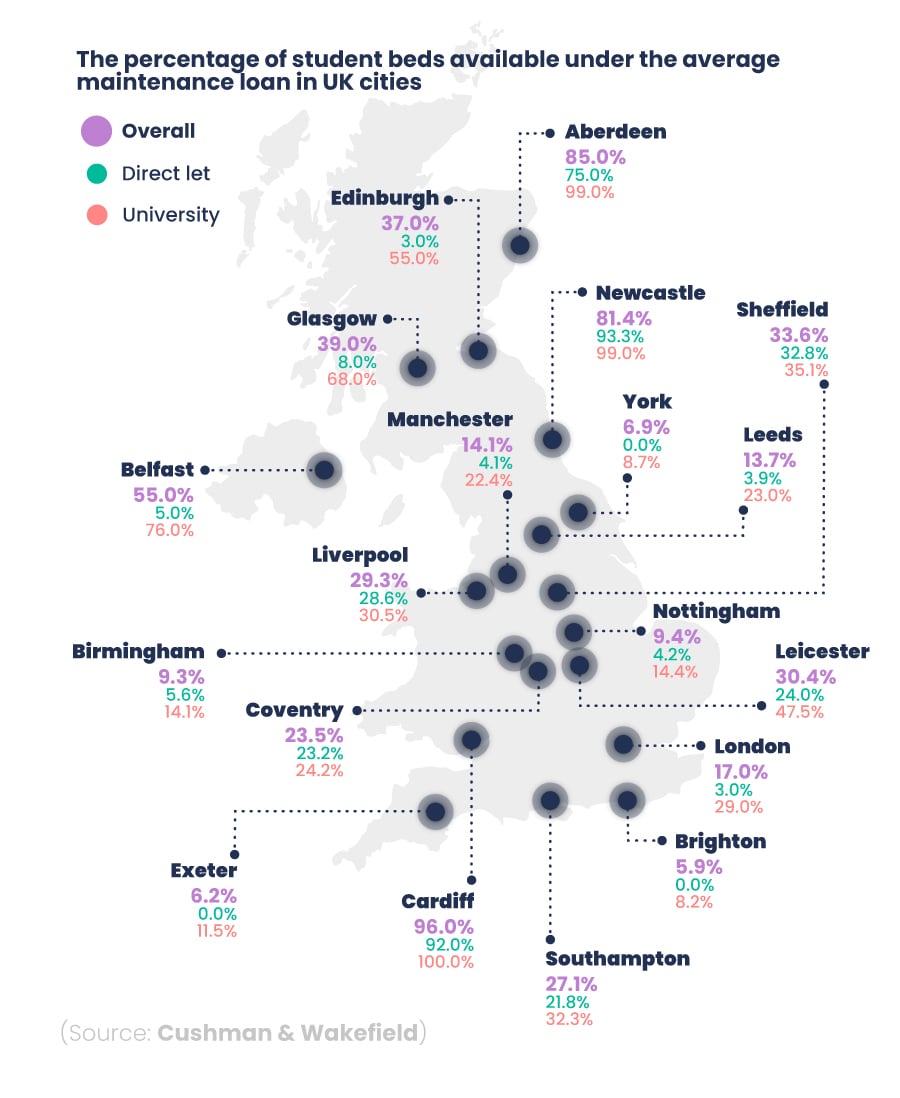
Cardiff stands out with the most housing options available under the average UK maintenance loan, where 96% of available student beds fit into this budget. Out of the 2 main accommodation types — direct let and university — institution-owned beds are the most affordable. That’s because 100% of institution-owned beds are under the value of a standard maintenance loan.
Aberdeen follows closely, indicating that 85% of student beds are available under the average maintenance loan. University accommodations are the most affordable in this location, with more than 9 in 10 (99%) housing options being under the maintenance loan available to students.
On the lower end of the spectrum, London, Brighton, and Exeter all show a smaller proportion of student beds available under the average maintenance loan. London, in particular, stands out with only 17% of student beds meeting this affordability baseline, reflecting the higher cost of living in the capital.
The maintenance loan is a large part of your income at university, but that’s not all of it. Find out more with our student finance statistics and facts.
What’s included in rent prices for student accommodation?
A survey carried out by Save the Student shows that electricity and water emerge as the most commonly included features. Over half (56% and 55%) of survey respondents indicated that these utilities are part of their rent in 2023.
A breakdown of what percentage of university students said these features were included in rent prices in 2023
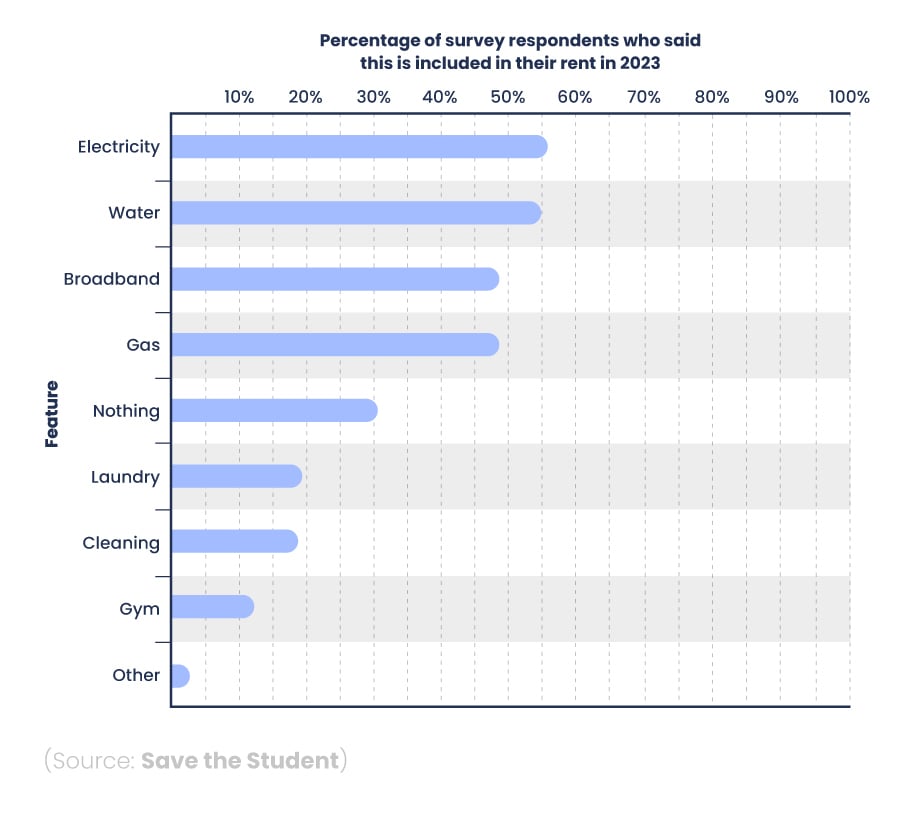
| Feature | Percentage of survey respondents who said this is included in their rent in 2023 |
|---|---|
|
Electricity
|
56%
|
|
Water
|
55%
|
|
Broadband
|
48%
|
|
Gas
|
48%
|
|
Nothing
|
31%
|
|
Laundry
|
19%
|
|
Cleaning
|
18%
|
|
Gym
|
12%
|
|
Other
|
2%
|
(Source: Save the Student)
Broadband is joint third for the most common features included in rent prices, with 48% of respondents mentioning that this service is part of their total. Gas joins broadband in third place, meaning that it’s less likely to be included in your rent between water, gas and electricity. While still a high percentage, gas is included in accommodation costs for 8% fewer students than electricity.
For some students, their rental fees cover additional services, albeit to a lesser extent. Approximately 19% of respondents indicate that laundry is included, while cleaning services are included for 18% of the surveyed students. 1 in 8 (12%) students also said their rent includes access to a gym.
Almost a third of students (31%) were responsible for covering all their utilities and amenities separately.
How students are funding their accommodation costs
Student accommodation statistics found that parents were the most common funding source for student rent. 31% of survey respondents indicated that they use parental support to pay for their accommodation.
A breakdown of what money sources students used to help pay their rent in 2023
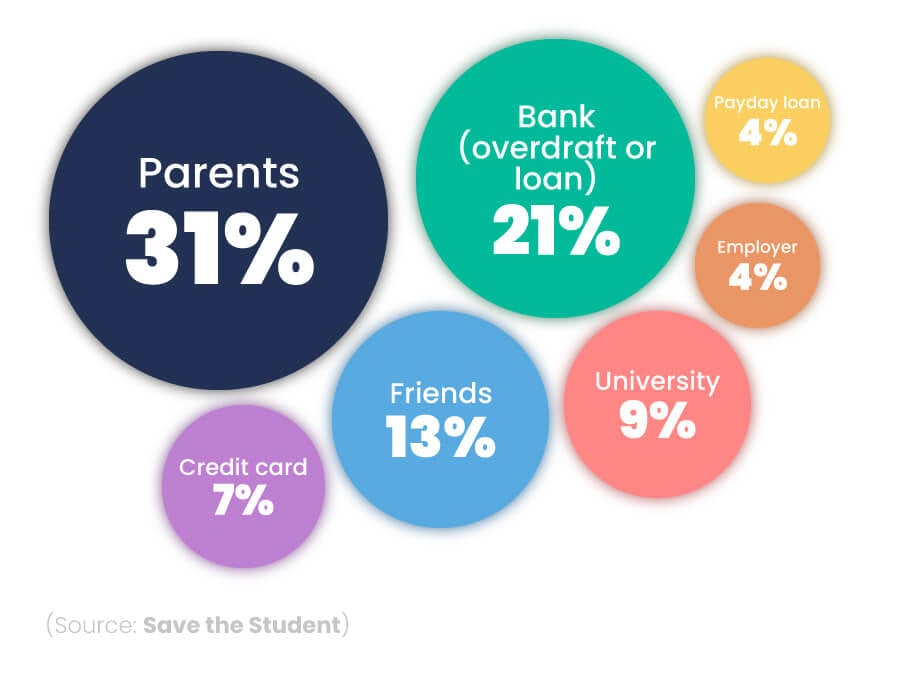
Bank resources, either through overdrafts or loans, constitute the second most utilised funding source. Over 1 in 5 (21%) students rely on these resources to cover their rent.
Friends contribute to the accommodation funding for 13% of the surveyed students, while university support is used by fewer than 1 in 10 (9%) respondents.
A smaller percentage of students resort to alternative financial sources, with:
- 7% using credit cards
- 4% relying on payday loans
- 4% securing funds from their employers
Student accommodation satisfaction statistics
Student accommodation satisfaction surveys by Knight Frank and Save the Student show how students feel about their housing. In 2022, just over half (52%) of students believed their accommodation was good value for money.
How many students would say their accommodation is good value for money?
The student accommodation satisfaction surveys show a gradual increase in students feeling their accommodation is good value for money.
A breakdown of survey respondents who said their student accommodation was ‘good’ or ‘extremely good’ value for money
| Year | Percentage of students rating their accommodation as ‘good’ or ‘extremely good’ value for money |
|---|---|
|
2020
|
49%
|
|
2021
|
51%
|
|
2022
|
52%
|
(Source: Knight Frank)
In 2020, nearly 5 in 10 (49%) students rated their accommodation as 'good' or 'extremely good' value for money. This percentage rose slightly to 51% in 2021.
The trend continued in 2022, with 52% of students expressing satisfaction with the value for money of their accommodation. This resulted in a 3% increase in contentment with student housing over the 3 years.
The type of accommodation students are most satisfied with
A student accommodation satisfaction survey by Knight Frank showed a studio or single-person flat in university halls was the best value for money. Almost two-thirds (62%) of students surveyed rated this as ‘good’ or ‘extremely good’.
A breakdown of which type of student accommodation survey respondents rated as ‘good’ or ‘extremely good’ value for money
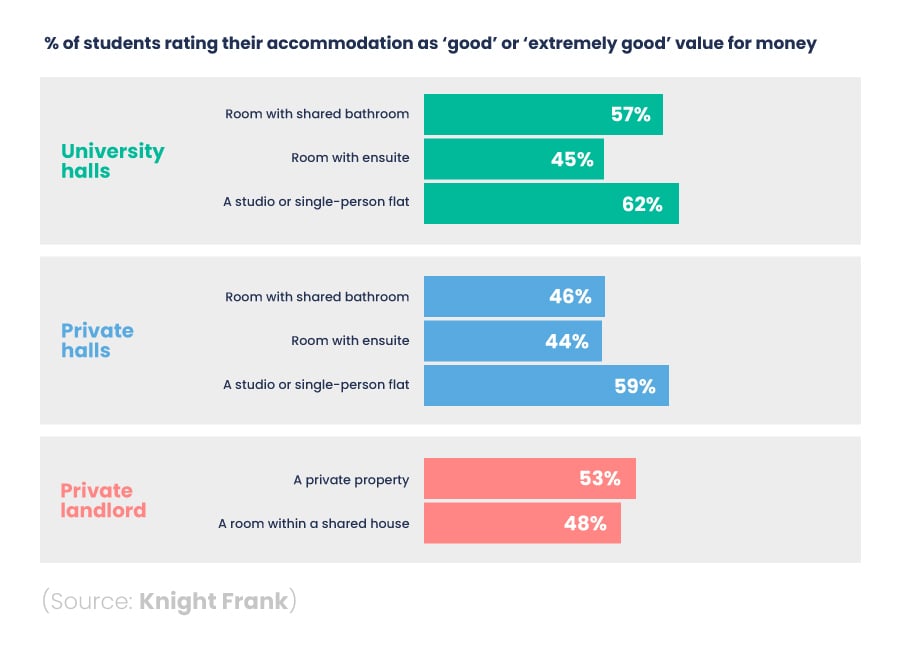
Students were most dissatisfied with rooms with ensuites in private halls. The 2022 survey showed that over two-fifths (44%) of students living in that room type thought it was good value for money.
When it comes to private landlords, a private property was deemed to be the best value for money. That’s instead of a room in a shared house (53% versus 48%).
Where students are most satisfied with their accommodation
On the whole, satisfaction levels are higher with university-owned PBSAs than with private landlords across the UK. The study showed that 7 out of 12 locations had higher percentages for this type of housing.
A breakdown of the student accommodation satisfaction levels across 12 UK cities
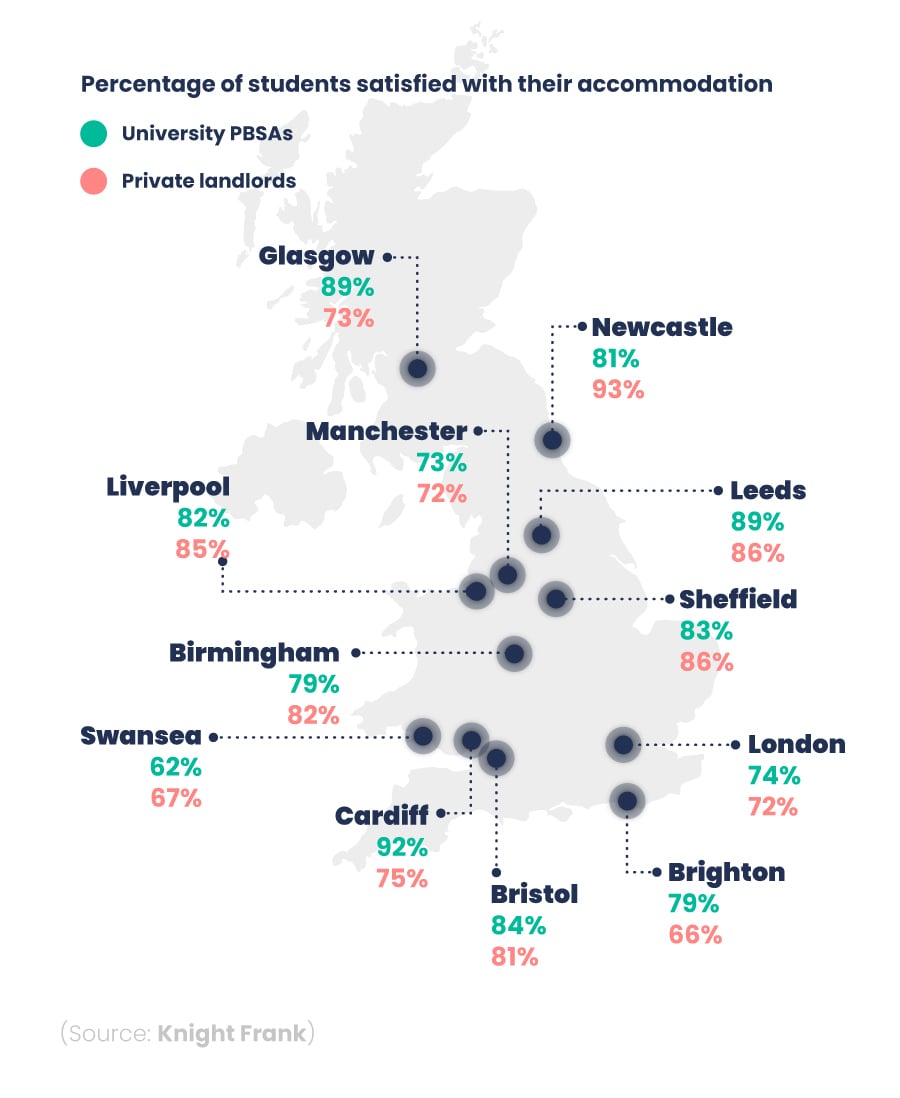
In several cities, university-managed PBSAs demonstrate high satisfaction levels, notably in Cardiff, Glasgow, and Leeds, where percentages range from 89% to 92%. This is highest in Cardiff where over 9 in 10 (92%) students were satisfied with their accommodation.
However, satisfaction percentages are the lowest across both types of accommodation in Swansea. 6 in 10 (62%) students were happy with their university-owned housing, while over two-thirds (67%) were satisfied with their private landlord in this location.
What student accommodation features are the most important?
In 2022, the majority of students emphasised the significance of organised groups or clubs to reduce loneliness and isolation. The Knight Frank survey showed 82% rated this feature as 'important' or 'very important’.
A breakdown of what accommodation features students rated as ‘important’ or ‘very important’ in 2021 and 2022

Good quality communal or social spaces within halls maintained their high importance in 2022. In the survey, 79% of students recognised the value of such spaces for improving interaction. This was a 1% increase from 2021.
There was a notable increase in the importance of accommodation workers (e.g., porters, security) being trained in understanding student wellbeing. The percentage rose from 67% in 2021 to 76% in 2022.
Students also feel gym access is important,rising by 11% from 66% in 2021 to 77% in 2022.
The biggest problems with student accommodation
Damp was the most common issue in housing, according to UK student accommodation statistics. Over a third (36%) of survey respondents reported this problem in 2023.
A breakdown of the issues students had in their student accommodation in 2023
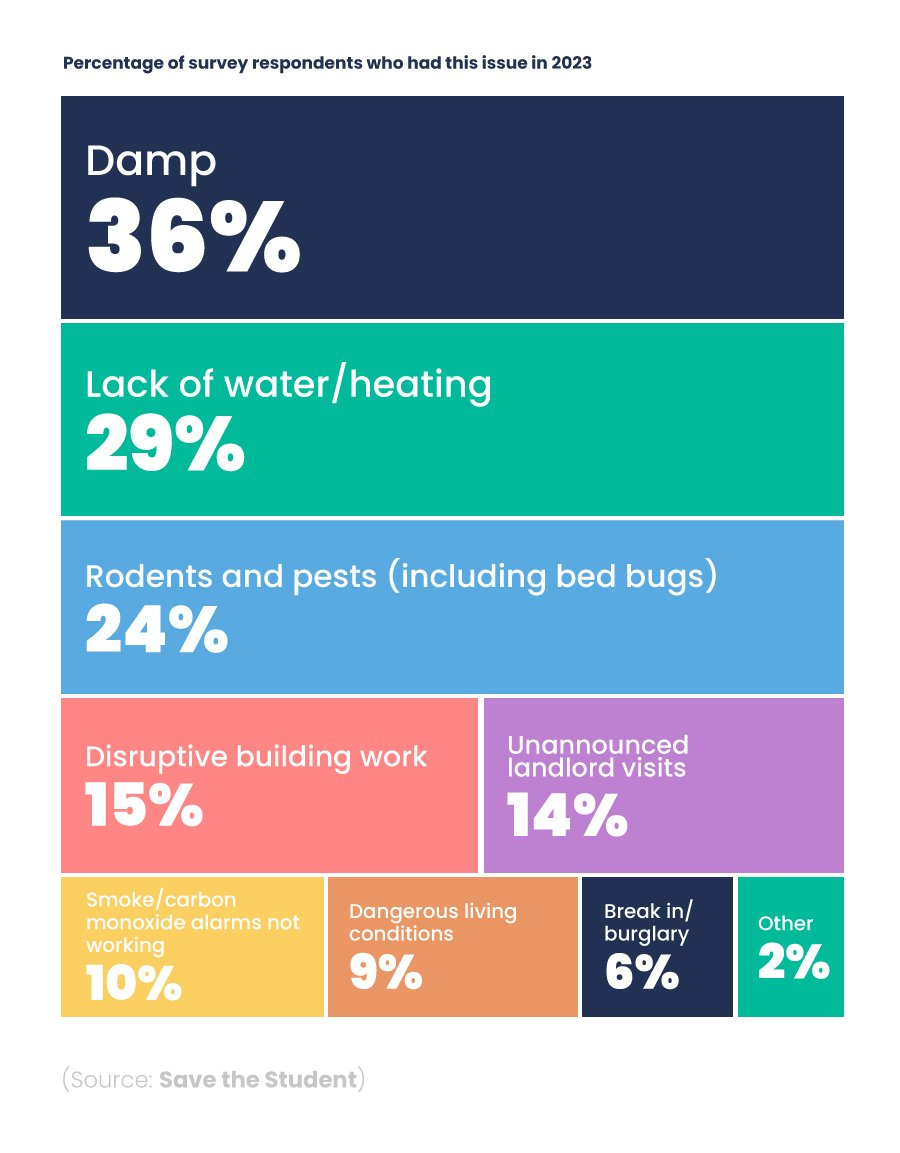
Lack of water or heating was the second most commonly reported problem, affecting almost 3 in 10 (29%) students.
Rodents and pests, including bed bugs, were reported by 24% of respondents in 2023. This is 9% more than the fourth most common student housing issue of disruptive building work.
Disruptive building work was reported by 1 in 6(15%) students. This figure was similar to that of unannounced landlord visits, which 14% of university students experienced in 2023. Landlord responsibilities state that 24 hours’ notice should be given to all tenants before visiting.
Other issues include non-functioning smoke/carbon monoxide alarms (10%), dangerous living conditions (9%), break-ins/burglaries (6%), and miscellaneous problems categorised as "Other" (2%).
FAQ about student accommodation in the UK
Does your student loan cover accommodation?
Student loans are there to help cover the costs of student accommodation, but the specifics depend on the loan amount and housing location.
There are 2 main loans students are entitled to, a tuition fee loan and a maintenance loan. Both of these loans only need to be paid back after you graduate and are earning over the repayment threshold. The yearly earnings threshold depends on the plan type you are:
- Plan 1 - £22,015
- Plan 2 - £27,295
- Plan 4 - £27,660
- Plan 5 - £25,000
Tuition fee loans cover the full tuition fees charged by your university or college. The Student Loans Company pays the loan amount directly to your course provider on your behalf. You do not receive this money yourself.
Maintenance loans are there to help with living costs while studying, such as accommodation, food, transport, and textbooks. However, there is a chance this loan won’t cover all of these costs outright, and some students need to supplement this with a part-time job. The maximum maintenance loan you can receive depends on where you study and live during term time, household income, and course length.
Can you get student accommodation as an apprentice?
It isn’t common for your apprenticeship academic provider to provide student accommodation, but they could:
- Suggest reputable letting agencies and property websites to browse available housing and landlord listings.
- Provide guidance on assessing factors like location, costs, amenities, and landlord reviews when shortlisting accommodation options to find the best fit.
- Advise booking short-term serviced apartments or hotels as transitional housing while you search for more permanent accommodation.
Most employers expect apprentices to find their own housing, but many still provide assistance during the relocation process. This differs from company to company, but some offer support by:
- Offering one-time financial subsidies for moving costs
- Giving local area guidance around proximity to the office, transportation, rent averages, etc.
- Covering temporary housing expenses while studying
Can you live in student accommodation during a placement year?
Many universities won’t offer accommodation during a placement year, with some only offering halls of residence for first-year students.
However, a lot of private PBSAs allow you to rent housing in your placement year. It’s important to note that during this time, you pay your maintenance loan at a reduced rate, even if your placement is unpaid.
Can you stay in student accommodation over the summer?
This depends on whether you live in university-owned or private accommodation. Some universities offer special rates to students who want to stay there over the summer and can guarantee housing for 365 days a year. Check with your institution to see their policies on this.
If you’re in private accommodation, thoroughly check your contract length to see if you can stay there in summer. If you have signed a contract that only covers the academic year (September to June), you likely won’t be able to extend over July and August.
How many weeks do you pay for student accommodation?
Student housing rental contracts often run in line with university term times, rather than a full 12-month period. Standard accommodation contracts are typically 40 weeks and exclude summer and winter holiday periods.
However, some university-owned housing operates 51-week or even 52-week tenancy agreements. Always confirm full contractual details, including occupancy start/end dates, when signing any agreements.
How do I find student accommodation?
To apply for university housing, you need to go through their accommodation office — most of the time, you can complete these applications online.
You might be asked to rank the housing options from your top choice to your last choice. But keep in mind that there are limited rooms available. With many students applying, the accommodation you want most might fill up quickly. So, apply as early as possible to have the best shot at one of the rooms high on your list.
For private housing, many universities offer a list of licensed landlords in the area and the student properties available. From here, you have to get in touch with the landlord and arrange viewings.
What is a guarantor for student accommodation?
You need to have a guarantor if you’re renting accommodation from a private landlord. This is a person who agrees to cover your rent in case you can’t make payments. Landlords and letting agents confirm guarantor details before approving tenancy agreements.
Guarantors are usually parents or family members willing and able to pay if you face financial troubles impacting rent. Make sure you discuss guarantor responsibilities openly before expecting someone to undertake long-term responsibilities.
Can a non-student live in student accommodation?
You are unlikely to be allowed to live in student accommodation, both private and university-owned, if you’re not a student. This is because PBSAs have been designed specifically for those studying at university.
Do students need home insurance?
As a student, you typically don’t need buildings insurance as you often live in rented accommodation. Instead, whoever owns the property will be responsible for landlord insurance.
You might find these types of student insurance policies useful though:
-
Tenants insurance (contents insurance for renters)
-
Car insurance (if you’re planning to have a vehicle at university)
Student Accommodation Glossary
PBSA
Purpose-built student accommodation (PBSA) refers to housing specially built for students. These can either be through the university or private companies.
PBSA is housing meant only for student living. They are built near universities to provide convenient accommodation.
HMO
A HMO is a house in multiple occupation. A home is considered an HMO if there are:
- At least 3 tenants forming more than 1 household (a household is usually a family or couple)
- Tenants who share bathrooms, toilets, or kitchen areas
This means that if you live at home with your family, then your house is not an HMO. However, in student accommodation, you often live with 2 or more people from outside of your family. This means it’s an HMO.
Maintenance loan
A maintenance loan is government-funded financial support for students that contributes to living costs while attending university. Typical expenses covered include accommodation costs, utility bills, food shopping, and materials needed for your course.
The maintenance loan funding amount depends on factors like your household income, where you study, and whether you live at home or away.
Sources
https://www.cushmanwakefield.com/en/united-kingdom/insights/uk-student-accommodation-report
https://sturentslistings.concurrent.co.uk/whats-in-store-for-student-accommodation-in-2024
https://www.hepi.ac.uk/2023/10/26/student-accommodation-costs-across-10-cities-in-the-uk
https://www.savethestudent.org/accommodation/national-student-accommodation-survey-2023.html

